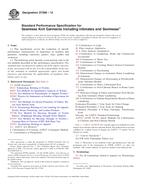This standard was transferred to SEMI (www.semi.org) May 2003
1.1 This practice recommends procedures for sampling polycrystalline silicon rods and growing single crystals from these samples by the float-zone technique. The resultant single crystal ingots are analyzed by spectrophotometric methods to determine the trace impurities in polysilicon. These trace impurities are acceptor (usually boron or aluminum, or both), donor (usually phosphorus or arsenic, or both), and carbon impurities.
1.2 The useful range of impurity concentration covered by this practice is 0.002 to 100 parts/billion atomic (ppba) for acceptor and donor impurities, and 0.05 to 5 parts/million atomic (ppma) for carbon impurity. These impurities are analyzed in the ingot samples by infrared or photoluminescence spectroscopy.
1.3 This practice is applicable only to evaluation of polysilicon ingots grown by a method that utilizes a slim silicon rod (filament) upon which polycrystalline silicon is deposited.
1.4 This practice uses hot acid to etch away the surface of the polysilicon rod. The etchant is potentially harmful and must be handled in an acid exhaust fume hood with utmost care at all times. Hydrofluoric acid solutions particularly are hazardous and should not be used by anyone who is not familiar with the specific preventative measures and first aid treatments given in the appropriate Material Safety Data Sheet.
1.5 This standard does not purport to address all of the safety concerns, if any, associated with its use. It is the responsibility of the user of this standard to establish appropriate safety and health practices and determine the applicability of regulatory limitations prior to use.
Product Details
- Published:
- 01/10/2002
- Number of Pages:
- 9
- File Size:
- 0 files


